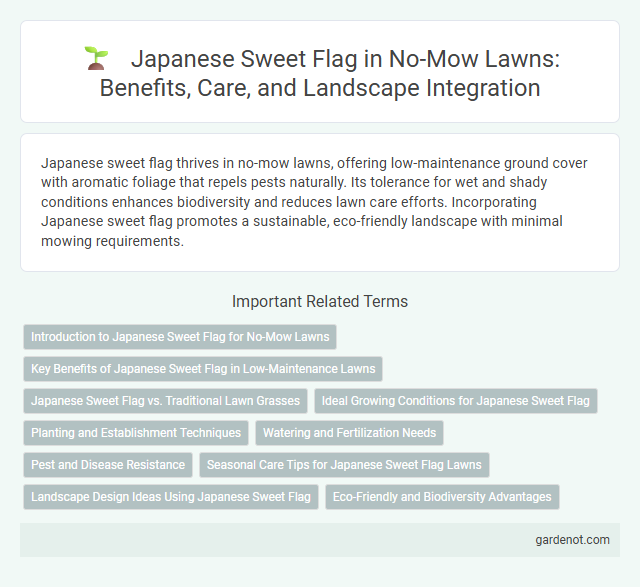Japanese sweet flag thrives in no-mow lawns, offering low-maintenance ground cover with aromatic foliage that repels pests naturally. Its tolerance for wet and shady conditions enhances biodiversity and reduces lawn care efforts. Incorporating Japanese sweet flag promotes a sustainable, eco-friendly landscape with minimal mowing requirements.
Introduction to Japanese Sweet Flag for No-Mow Lawns
Japanese sweet flag (Acorus gramineus) thrives in no-mow lawns due to its low-growing, grass-like foliage that maintains a neat appearance without regular mowing. This perennial plant adapts well to moist, shaded areas and helps suppress weeds, enhancing lawn biodiversity and reducing maintenance needs. Its fragrant leaves offer a unique sensory experience, making Japanese sweet flag an ideal choice for sustainable, low-maintenance landscapes.
Key Benefits of Japanese Sweet Flag in Low-Maintenance Lawns
Japanese Sweet Flag (Acorus gramineus) enhances low-maintenance lawns by offering drought tolerance and shade adaptability, reducing the need for frequent watering and mowing. Its dense, grass-like foliage suppresses weed growth naturally, minimizing the use of herbicides. This perennial ground cover also improves soil erosion control, promoting healthier and more sustainable lawn ecosystems.
Japanese Sweet Flag vs. Traditional Lawn Grasses
Japanese Sweet Flag (Acorus gramineus) offers a low-maintenance alternative to traditional lawn grasses, thriving with minimal mowing and watering requirements. Unlike conventional turfgrass species like Kentucky bluegrass or fescue, Japanese Sweet Flag tolerates shade and moist conditions while maintaining a dense, lush ground cover. Its slow growth rate and natural resistance to pests make it ideal for sustainable no-mow lawns, reducing labor and resource consumption significantly.
Ideal Growing Conditions for Japanese Sweet Flag
Japanese sweet flag (Acorus gramineus) thrives in consistently moist to wet soil, making it an excellent choice for no-mow lawns in shaded or partially shaded areas. This perennial plant prefers acidic to neutral pH levels, ranging from 5.5 to 7.0, and benefits from rich, organic soil that retains moisture without becoming waterlogged. It is tolerant of a range of temperatures but grows best in USDA hardiness zones 5 through 9, where it can establish dense, low-maintenance ground cover.
Planting and Establishment Techniques
Japanese sweet flag (Acorus gramineus) thrives in moist, well-drained soils and partial shade, making it an ideal choice for no-mow lawns in damp areas. Plant rhizomes or division segments about 12 inches apart, buried 1 to 2 inches deep, to ensure quick establishment and dense ground cover. Regular watering during the first growing season promotes root development, while minimal maintenance supports sustainable growth without frequent mowing.
Watering and Fertilization Needs
Japanese sweet flag thrives in consistently moist soil, requiring regular watering to maintain its preference for wet environments, especially during dry periods. Fertilization benefits from a balanced, slow-release fertilizer applied in early spring to promote healthy growth and vibrant foliage. Overwatering beyond moisture preference can lead to root rot, so careful monitoring of soil moisture levels is essential for optimal plant health.
Pest and Disease Resistance
Japanese sweet flag (Acorus gramineus) exhibits strong pest and disease resistance, making it an ideal choice for no-mow lawn settings where minimal maintenance is desired. Its natural compounds deter common lawn pests such as aphids and spider mites while showing resilience against fungal infections like powdery mildew. This hardy groundcover supports sustainable landscaping efforts by reducing the need for chemical pesticides and frequent lawn care.
Seasonal Care Tips for Japanese Sweet Flag Lawns
Japanese sweet flag lawns thrive with consistent moisture during spring and summer, requiring regular watering to maintain vibrant green foliage. In autumn, trimming back dead leaves enhances growth and prevents mold, while applying a balanced fertilizer supports root development. Winter protection includes mulching to insulate the soil and reduce frost damage, ensuring healthy renewal in the following growing season.
Landscape Design Ideas Using Japanese Sweet Flag
Japanese sweet flag (Acorus gramineus) enhances landscape design with its vibrant green, grass-like foliage and graceful texture, ideal for border plantings and ground cover in no-mow lawns. Its tolerance to moist or shaded areas adds versatility, making it perfect for water features, garden edges, and naturalistic settings. Incorporating Japanese sweet flag creates a low-maintenance, visually appealing landscape that complements eco-friendly, sustainable lawn concepts.
Eco-Friendly and Biodiversity Advantages
Japanese sweet flag (Acorus gramineus) enhances eco-friendly lawn alternatives by reducing the need for mowing, thus minimizing carbon emissions and fossil fuel consumption. Its dense foliage supports local biodiversity by providing habitat and food for beneficial insects and soil microorganisms. This sustainable ground cover improves soil health and water retention, promoting a balanced ecosystem in no-mow lawn settings.
Japanese sweet flag Infographic

 gardenot.com
gardenot.com